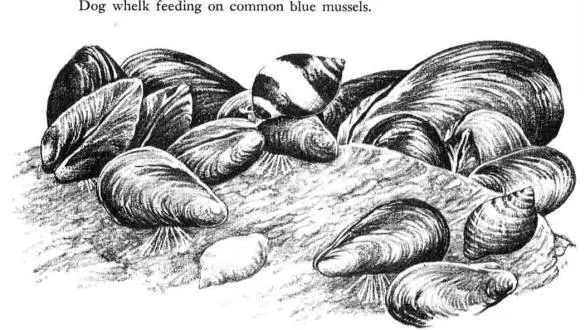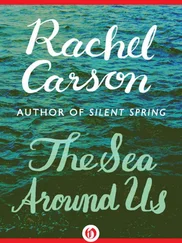Rachel Carson - The Edge of the Sea
Здесь есть возможность читать онлайн «Rachel Carson - The Edge of the Sea» весь текст электронной книги совершенно бесплатно (целиком полную версию без сокращений). В некоторых случаях можно слушать аудио, скачать через торрент в формате fb2 и присутствует краткое содержание. Город: Boston, Год выпуска: 1998, ISBN: 1998, Издательство: Mariner Books, Жанр: Биология, sci_ecology, sci_popular, на английском языке. Описание произведения, (предисловие) а так же отзывы посетителей доступны на портале библиотеки ЛибКат.
- Название:The Edge of the Sea
- Автор:
- Издательство:Mariner Books
- Жанр:
- Год:1998
- Город:Boston
- ISBN:978-0-395-07505-0
- Рейтинг книги:4 / 5. Голосов: 1
-
Избранное:Добавить в избранное
- Отзывы:
-
Ваша оценка:
- 80
- 1
- 2
- 3
- 4
- 5
The Edge of the Sea: краткое содержание, описание и аннотация
Предлагаем к чтению аннотацию, описание, краткое содержание или предисловие (зависит от того, что написал сам автор книги «The Edge of the Sea»). Если вы не нашли необходимую информацию о книге — напишите в комментариях, мы постараемся отыскать её.
A book to be read for pleasure as well as a practical identification guide,
introduces a world of teeming life where the sea meets the land. A new generation of readers is discovering why Rachel Carson’s books have become cornerstones of the environmental and conservation movements. New introduction by Sue Hubbell.
The Edge of the Sea — читать онлайн бесплатно полную книгу (весь текст) целиком
Ниже представлен текст книги, разбитый по страницам. Система сохранения места последней прочитанной страницы, позволяет с удобством читать онлайн бесплатно книгу «The Edge of the Sea», без необходимости каждый раз заново искать на чём Вы остановились. Поставьте закладку, и сможете в любой момент перейти на страницу, на которой закончили чтение.
Интервал:
Закладка:
When, through the attacks of fish, predatory worms, or snails, or through natural causes, the barnacle’s life comes to an end, the shells remain attached to the rocks. These become shelter for many of the minute beings of the shore. Besides the baby periwinkles that regularly live there, the little tide-pool insects often hurry into these shelters if caught by the rising tide. And lower on the shore, or in tide pools, the empty shells are likely to house young anemones, tube worms, or even new generations of barnacles.
The chief enemy of the barnacle on these shores is a brightly colored carnivorous marine snail, the dog whelk. Although it preys also on mussels and even occasionally on periwinkles, it seems to prefer barnacles to all other food, probably because they are more easily eaten. Like all snails, the whelk possesses a radula. This is not used, periwinkle fashion, to scrape the rocks, but to drill a hole in any hard-shelled prey. It can then be pushed through the hole it has made, to reach and consume the soft parts within. To devour a barnacle, however, the whelk need only envelop the cone within its fleshy foot and force the valves open. It also produces a secretion that may have a narcotic effect. This is a substance called purpurin. In ancient times the secretion of a related snail in the Mediterranean was the source of the dye Tyrian purple. The pigment is an organic compound of bromine that changes in air to form a purple coloring matter.
Although violent surf excludes them, the dog whelks appear in numbers on most open shores, working up high into the zone of the barnacles and mussels. By their voracious feeding they may actually alter the balance of life on the shore. There is a story, for example, about an area where the whelks had reduced the number of barnacles so drastically that mussels came in to fill the vacant niche. When the whelks could find no more barnacles they moved over to the mussels. At first they were clumsy, not knowing how to eat the new food. Some spent futile days boring holes in empty shells; others climbed into empty shells and bored from inside. In time, however, they adjusted to the new prey and ate so many mussels that the colony began to dwindle. Then the barnacles settled anew on the rocks and in the end the snails returned to them.

In the middle stretches of shore and even down toward the low-tide line the whelks live under the dripping curtains of weed hanging down from the rock walls, or within the turf of Irish moss or among the flat, slippery fronds of the red seaweed, dulse. They cling to the under sides of overhanging ledges or gather in deep crevices where salt water drips from weeds and mussels, and little streams of water trickle over the floor. In all such places the whelks collect in numbers to pair and lay their eggs in straw-colored containers, each about the size and shape of a grain of wheat and tough as parchment. Each capsule stands alone, attached by its own base to the substratum, but usually they are crowded so closely together that they form a pattern or mosaic.
A snail takes about an hour to make one capsule but seldom completes more than 10 in twenty-four hours. It may produce as many as 245 in a season. Although a single capsule may contain as many as a thousand eggs, most of these are unfertilized nurse eggs that serve as food for the developing embryos. On maturing, the capsules become purple, being colored by the same chemical purpurin that is secreted by the adult. In about four months embryonic life is completed, and from 15 to 20 young dog whelks emerge from the capsule. Newly hatched young seldom if ever are found in the zone where the adults live, although the capsules are deposited and development takes place there. Apparently the waves carry the young snails down to low-tide level or below. Probably many are washed out to sea and lost, but the survivors are to be found at low water. They are very small—about one-sixteenth of an inch high—and are feeding on the tube worm, Spirorbis. Apparently the tubes of these worms are easier to penetrate than the cones of even very small barnacles. Not until the dog whelk is about one-fourth or three-eighths of an inch high does it migrate higher on the shore and begin feeding on barnacles.

Down in the middle sections of the shore the limpets become abundant. They appear sprinkled over the open rock surfaces, but most live numerously in shallow tide pools. A limpet wears a simple cone of shell the size of a fingernail, unobtrusively mottled with soft browns and grays and blues. It is one of the most ancient and primitive types of snails, and yet the primitiveness and the simplicity are deceptive. The limpet is adapted with beautiful precision to the difficult world of the shore. One expects a snail to have a coiled shell; the limpet has instead a flattened cone. The periwinkles, which have coiled shells, are often rolled around by the surf unless they have hidden themselves securely in crevices or under weeds. The limpet merely presses its cone against the rocks and the water slides over the sloping contours without being able to get a grip; the heavier the waves, the more tightly they press it to the rocks. Most snails have an operculum to shut out enemies and keep moisture inside; the limpet has one in infancy and then discards it. The fit of the shell to the substratum is so close that an operculum is unnecessary; moisture is retained in a little groove that runs around just inside the shell, and the gills are bathed in a small sea of their own until the tide returns.
Ever since Aristotle reported that limpets leave their places on the rocks and go out to feed, people have been recording facts about their natural history. Their supposed possession of a sort of homing sense has been widely discussed. Each limpet is said to possess a “home” or spot to which it always returns. On some types of rock there may be a recognizable scar, either a discoloration or a depression, to which the contours of the shell have become precisely fitted. From this home the limpet wanders out on the high tides to feed, scraping the small algae off the rocks by licking motions of the radula. After an hour or two of feeding it returns by approximately the same path, and settles down to wait out the period of low water.

Many nineteenth-century naturalists tried unsuccessfully to discover by experiment the nature of the sense involved and the organ in which the homing sense resides, much as modern scientists try to find a physical basis for the homing abilities of birds. Most of these studies dealt with the common British limpet, Patella, and although no one could explain how the homing instinct worked, there seemed to be little doubt in anyone’s mind that it did work, and with great precision.
In recent years American scientists have investigated the matter with statistical methods, and some have concluded that Pacific coast limpets do not “home” very well at all. (No careful studies of homing have been made among New England limpets.) Other recent work in California, however, supports the homing theory. Dr. W. G. Hewatt marked a large number of limpets and their homes with identifying numbers. He found that on each high tide all the limpets left home, wandered about for some two and a half hours, then returned. The direction of their excursions changed from tide to tide, but they always returned to the home spot. Dr. Hewatt tried filing a deep groove across one animal’s homeward path. The limpet halted on the edge of the groove and spent some time confronting this dilemma, but on the next tide it moved around the edge of the groove and returned home. Another limpet was taken about nine inches from its home and the edges of its shell were filed smooth. It was then released on the same spot. It returned to its home, but presumably the exact fit of shell to rock home had been destroyed by the filing and the next day the limpet moved about twenty-one inches away and did not return. On the fourth day it had taken up a new home and after eleven days it disappeared.
Читать дальшеИнтервал:
Закладка:
Похожие книги на «The Edge of the Sea»
Представляем Вашему вниманию похожие книги на «The Edge of the Sea» списком для выбора. Мы отобрали схожую по названию и смыслу литературу в надежде предоставить читателям больше вариантов отыскать новые, интересные, ещё непрочитанные произведения.
Обсуждение, отзывы о книге «The Edge of the Sea» и просто собственные мнения читателей. Оставьте ваши комментарии, напишите, что Вы думаете о произведении, его смысле или главных героях. Укажите что конкретно понравилось, а что нет, и почему Вы так считаете.












